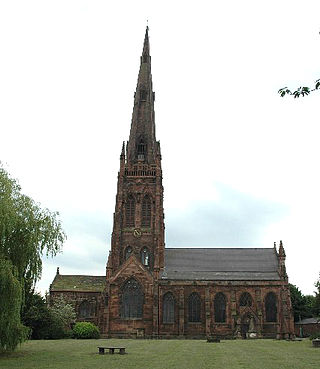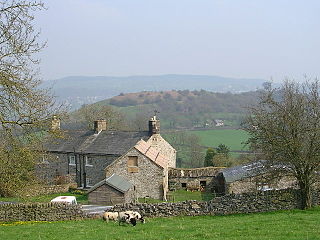Related Research Articles

Bakewell is a market town and civil parish in the Derbyshire Dales district of Derbyshire, England, known for Bakewell pudding. It lies on the River Wye, 13 miles (21 km) south-west of Sheffield. At the 2011 census, the population of the civil parish was 3,949. It was estimated at 3,695 in 2019. The town is close to the tourist attractions of Chatsworth House and Haddon Hall.

Matlock is the county town of Derbyshire, England. It is in the south-eastern part of the Peak District, with the National Park directly to the west. The spa resort of Matlock Bath is immediately south of the town as well as Cromford lying further south still. The civil parish of Matlock Town had a population in the 2021 UK census of 10,000.

Darley Dale, formerly Darley, is a town and civil parish in the Derbyshire Dales district of Derbyshire, England, with a population of 5,413. It lies north of Matlock, on the River Derwent and the A6 road. The town forms part of a built-up area with both Matlock and Rowsley.
Peak Rail is a preserved railway in Derbyshire, England, which operates a steam and heritage diesel service for tourists and visitors to both the Peak District and the Derbyshire Dales.

Darley Abbey is a former historic mill village, now a suburb of the city of Derby, England. It is located approximately 1.4 miles (2.3 km) north of the city centre, on the west bank of the River Derwent, and forms part of the Darley ward along with Little Chester and the West End. The settlement dates back to the medieval era, when it was the site of an Augustinian monastery. In the 18th century, the Evans family developed their planned industrial mill village in the area; Darley Abbey is now part of the Derwent Valley Mills World Heritage Site.

St Mary's Church is in the West Bank area of Widnes, Cheshire, England. The church is recorded in the National Heritage List for England as a designated Grade II* listed building. It is an active Anglican parish church in the diocese of Liverpool, the archdeaconry of Warrington and the deanery of Widnes. Together with the churches of St Paul, Widnes, and St Mary, Hale, it forms the South Widnes Team. It has been described as "the last great church masterpiece" created by the Lancaster architects Austin and Paley.

St Elphin's Church is the parish church of the town of Warrington, Cheshire, England. The church is recorded in the National Heritage List for England as a designated Grade II* listed building. It is an active Anglican parish church in the diocese of Liverpool, the archdeaconry of Warrington and the deanery of Warrington.

Holy Trinity Church is in the centre of the town of Warrington, Cheshire, England. The church is recorded in the National Heritage List for England as a designated Grade II* listed building. It is an active Anglican parish church in the diocese of Liverpool, the archdeaconry of Warrington and the deanery of Warrington.

Hackney and Upper Hackney are areas of settlement in Derbyshire, England. The population taken at the 2011 Census is included in the civil parish of Darley Dale.

Wensley is a small village in South Darley parish in Derbyshire of limestone and gritstone properties mainly arranged along the single road which zig-zags through the village or around the square. The whole village, together with part of the adjacent Wensley Dale is a Conservation Area. Until fairly recently there was a Methodist Chapel, a village shop and two public houses, but these have all closed. The former school is now a village hall, Wensley Reading Room. Quite a few of the houses are holiday lets.
St Brandon's School was an independent school incorporating an infant and junior school and a senior boarding school for girls, located in the town of Clevedon in Somerset, in South West England. The school was opened in 1831 and closed in 2004.

St John the Evangelist's Church is on Warrington Road in Abram, Wigan, Greater Manchester, England. It is an active Anglican parish church in the deanery of Wigan, the archdeaconry of Warrington, and the diocese of Liverpool. The church was built in 1935–37 to replace an older church built in 1838 that had been damaged by mining subsidence.

Darley Bridge is a village in Derbyshire, located in South Darley parish in the Derbyshire Dales, bordering the Peak District. The village lies at the bottom of the hill below Wensley where the road crosses the River Derwent. A grade II* listed stone bridge spans the river and links the village with Darley Dale. Close to the bridge, the road winds between terraced stone houses in the oldest part of the village. The only public house in the parish, The Three Stags Heads, is in this area.
The archdeacons in the Diocese of Liverpool are senior ecclesiastical officers in the Church of England in a highly irregular area surrounding the city of Liverpool. They are the archdeacons of Liverpool, of St Helens and Warrington, of Knowsley and Sefton, and of Wigan and West Lancashire; each one has responsibility over a geographical area within the diocese. The archdeacons are responsible for the disciplinary supervision of the clergy within their archdeaconries.

William Owen was an English architect who practised in Warrington, which was at that time in Lancashire, England. His works were confined to Northwest England. Owen is best known for his collaboration with William Lever in the creation of the soap-making factory and associated model village at Port Sunlight in the Wirral Peninsula. Here he designed the factory, many of the workers' houses, public buildings and the church. Later Owen was joined by his son, Segar, as a partner. On his own, or in partnership, Owen designed houses, churches, banks, public houses, an infirmary, a school, and a concert hall.
Elphin of Warrington was a Christian saint who lived in the North West of England in the 7th century, and is considered the patron saint of the town of Warrington.
Audley Group is a builder and manager in the British retirement property industry. The company's based in Egham and has two property brands in the UK - Audley Villages, formerly known as Audley Retirement and Mayfield Villages.

South Darley is a civil parish in the Derbyshire Dales. It is a largely rural parish and covers the villages of Darley Bridge, Wensley and the hamlets of Oker and Snitterton. South Darley lies west of Matlock and east of Winster. The River Derwent forms the north-eastern boundary of South Darley parish with Darley Dale parish on the other bank. About two thirds of the parish lies within the Peak District.

Northwood and Tinkersley is a civil parish within the Derbyshire Dales district, in the county of Derbyshire, England. Named for its main settlements, with a mix of rural and built up areas, it had a population of 665 residents in 2011. The parish is 126 miles (203 km) north west of London, 18 miles (29 km) north west of the county city of Derby, and 3+1⁄2 miles (5.6 km) north west of the nearest market town of Matlock. Northwood and Tinkersley is directly adjacent to the Peak District national park to the west, and shares a border with the parishes of Darley Dale, Rowsley and Stanton.
Darley Dale is a civil parish in the Derbyshire Dales district of Derbyshire, England. The parish contains 27 listed buildings that are recorded in the National Heritage List for England. Of these, three are listed at Grade II*, the middle of the three grades, and the others are at Grade II, the lowest grade. The parish contains the town of Darley Dale and the surrounding area. Most of the listed buildings are houses, cottages and associated structures, farmhouses and farm buildings. The other listed buildings include a church and its former rectory, a road bridge over the River Derwent, public houses, a mile post and a milestone, buildings associated with Darley Dale railway station, an institute, and a school.
References
- 1 2 3 "The Story of St Elphin's School, 1844-1944, ML Flood". Archived from the original on 3 March 2016. Retrieved 15 April 2013.
- ↑ Matlock Mercury 29 January 2004: St Elphin's to close?, accessed 15 April 2013
- ↑ "Audley St Elphin's Park Retirement Village". Audley Villages.
- ↑ Polly Bagnall & Sally Beck (2015). Ferguson's Gang: The Remarkable Story of the National Trust Gangsters. Pavilion Books. p. 69. ISBN 978-1909881716.